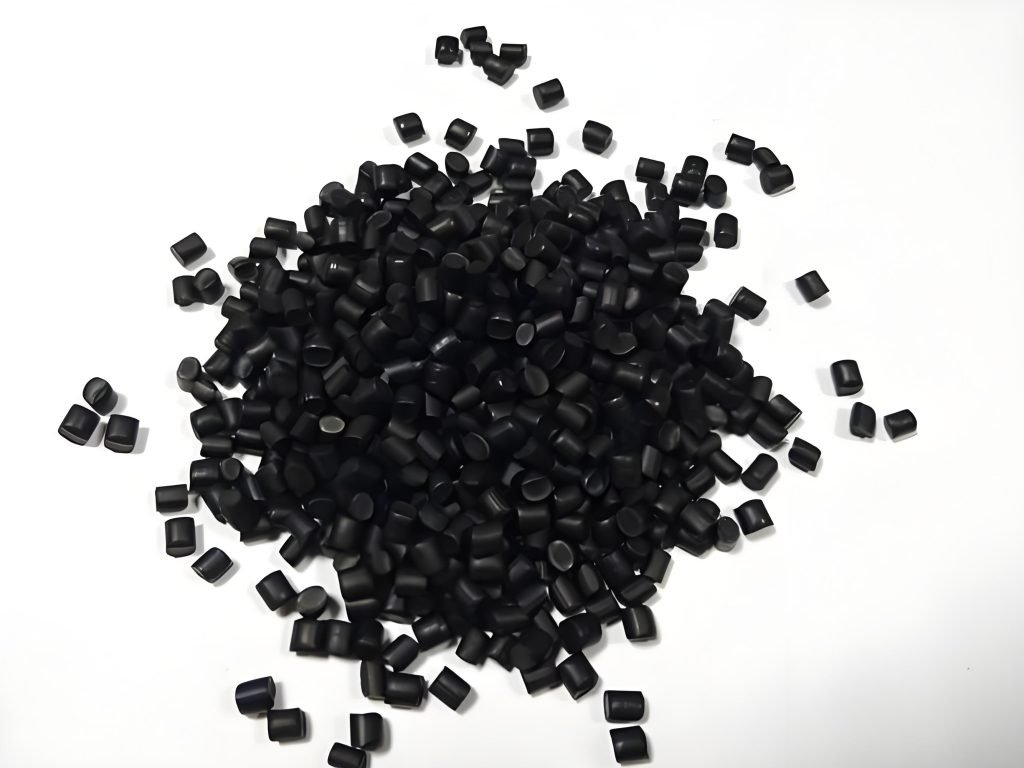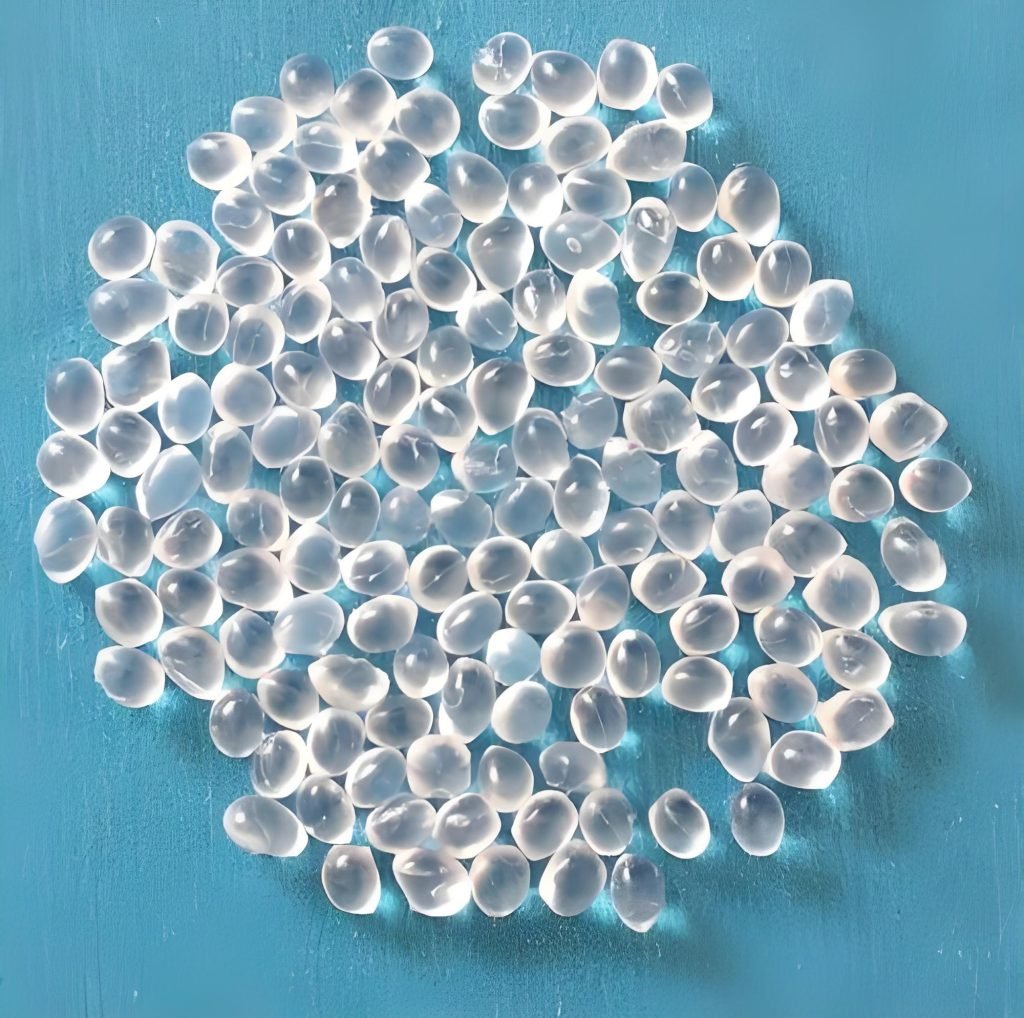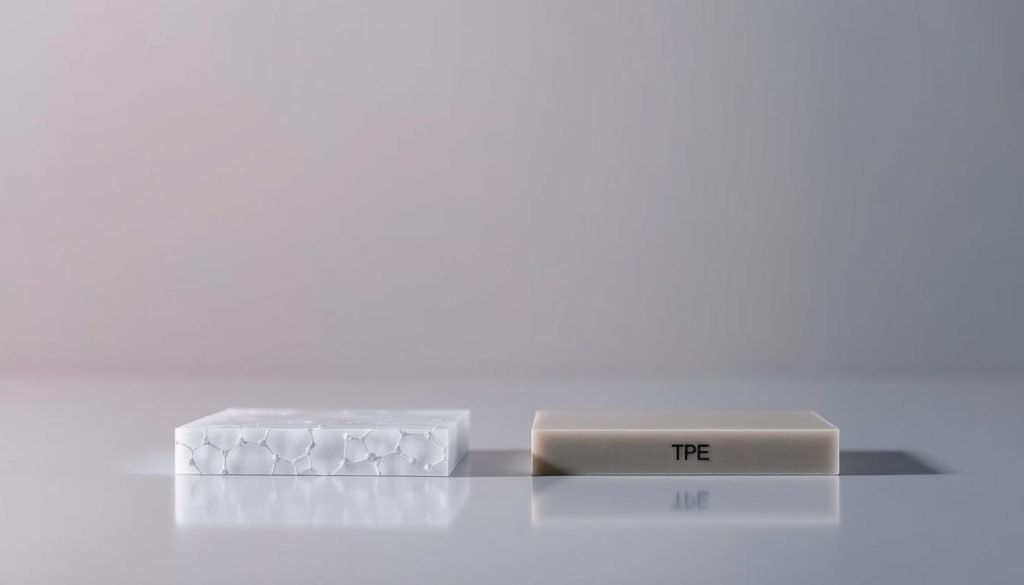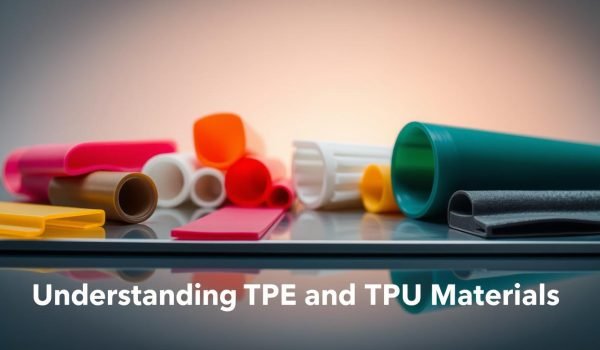Are you struggling to decide between Thermoplastic Polyurethane (TPU) and Thermoplastic Elastomer (TPE) for your manufacturing needs? Both materials have gained popularity as alternatives to natural rubber latex and silicone in various applications, from medical devices to automotive parts.
Understanding the differences between these versatile materials is crucial for making informed decisions. TPU and TPE offer unique properties that make them suitable for different applications. This article will guide you through their key differences, typical uses, and how to select the right material based on your project requirements.
Understanding TPE and TPU Materials
To make informed decisions in manufacturing, it’s crucial to understand the basics of TPE and TPU materials. These materials have revolutionized the industry by offering alternatives to traditional rubber that combine elasticity with the processing advantages of plastics.
What Are Thermoplastic Materials?
Thermoplastic materials are a category of polymers that become pliable or moldable above a specific temperature and solidify upon cooling. This property allows for repeated heating and cooling cycles without significant degradation.
Why These Materials Are Important in Manufacturing
TPE and TPU are significant in manufacturing due to their compatibility with various processing techniques such as extrusion and injection molding. They offer excellent resistance to various conditions, making them suitable for different applications.
Common Misconceptions About TPE and TPU
A common misconception is that TPE and TPU are interchangeable terms. However, TPU is a specific subset of the broader TPE family with distinct characteristics. Understanding these differences is crucial for optimizing product performance and durability.
What is TPE (Thermoplastic Elastomer)?

TPE, or Thermoplastic Elastomer, is a versatile material that has gained popularity for its unique blend of elasticity and processability. It is an alloy material with a multi-phase structure aggregated by multi-component blending.
Composition and Structure of TPE
The composition of TPE consists of multiple polymer phases, creating a material with excellent flexibility and elasticity while maintaining good dimensional stability and chemical inertness. Its block copolymer structure includes hard and soft segments, giving TPE its unique properties.
Key Properties and Characteristics
TPE offers a wide range of hardness options, typically excelling in the medium to low hardness range, making it suitable for applications requiring a soft touch and comfort. Its exceptional flexibility, lighter weight, and softer feel compared to many other materials make it ideal for consumer-facing products.
Advantages and Limitations of TPE
One of the primary advantages of TPE is its flexibility and ease of recycling. However, TPE’s limitations include lower resistance to extreme temperatures, reduced chemical resistance, and less durability against abrasion compared to TPU.
What is TPU (Thermoplastic Polyurethane)?
Thermoplastic Polyurethane, or TPU, is a versatile material that has gained popularity since its introduction in 1959. It serves as a bridge between flexible rubber thermoplastics and rigid plastics, offering a unique combination of properties.
Composition and Structure of TPU
TPU is characterized by its homogeneous polymer structure, consisting of alternating hard and soft segments. This composition contributes to its superior performance characteristics, including elasticity and resistance to abrasion.
Key Properties and Characteristics
TPU exhibits outstanding abrasion resistance, excellent chemical resistance, and impressive durability across a wide temperature range. Its customizable hardness range allows manufacturers to fine-tune the material for specific requirements, making it suitable for demanding applications.
Advantages and Limitations of TPU
The primary advantages of TPU include its superior resistance to oils, chemicals, and extreme temperatures, as well as its exceptional durability and load-bearing capacity. However, TPU is less flexible than TPE and may have a rougher feel, which can be a limitation in certain applications.

TPU vs TPE: Direct Comparison
When deciding between TPU and TPE for your project, understanding their differences is crucial. Both materials have their unique properties and applications, making the choice between them dependent on several factors.
Physical Properties Comparison
TPU and TPE differ significantly in their physical properties. TPE is generally softer and more flexible, while TPU offers superior tensile strength and abrasion resistance. This makes TPU more suitable for applications requiring durability.
Performance in Different Environments
TPU outperforms TPE in extreme temperatures, maintaining its properties across a wider temperature range. TPU is also more resistant to chemicals, oils, and abrasion, making it ideal for harsh environments.
Durability and Longevity
TPU excels in durability due to its superior abrasion resistance and tear strength. This results in longer-lasting products, especially in high-wear applications.
Cost Considerations
While TPE typically offers a lower initial investment, TPU’s extended service life and superior performance often justify its higher cost in demanding applications.
Typical Applications for TPE and TPU
Both TPE and TPU have a wide range of applications across different industries, from consumer products to automotive components. Understanding these applications is key to choosing the right material for your needs.
Industries That Rely on TPE
TPE is highly versatile and used in various industries due to its flexibility and comfort. It is particularly favored in applications that require a soft touch.
Medical and Healthcare Applications
The medical and healthcare industries heavily rely on TPE for applications such as surgical tubing, IV components, and medical device housings. Its biocompatibility and flexibility make it an ideal choice.
Consumer Products and Automotive Uses
In consumer products, TPE is used in items like toothbrush handles, baby products, and toys, where a soft touch feel is paramount. The automotive industry also utilizes TPE for interior components and weather seals.
Industries That Rely on TPU
TPU is known for its high strength and durability, making it suitable for demanding applications.
High-Performance Applications
TPU dominates high-performance applications such as industrial belting, hydraulic hoses, and mechanical parts, where abrasion resistance and durability are critical.
Protective and Durable Products
Protective products like phone cases, sports equipment, and safety gear frequently use TPU for its superior impact resistance and durability.
Overlapping Applications
Both TPE and TPU find applications in areas like cable jacketing, footwear components, and certain medical devices. The choice between them often depends on specific performance requirements and cost considerations.
How to Select the Right Material for Your Project

To make an informed decision between TPU and TPE, you need to assess your project’s requirements. This involves considering several key factors that will influence the performance and suitability of the chosen material.
Assessing Your Project Requirements
Begin by evaluating your project’s specific needs, including flexibility, load-bearing capacity, and expected wear conditions. Consider whether the application involves direct contact with users.
Environmental Considerations
Consider the environmental conditions your product will face. TPU outperforms TPE in extreme temperatures and outdoor applications where UV resistance is crucial.
Manufacturing Process Compatibility
Evaluate your manufacturing processes. Both TPE and TPU are compatible with injection molding and extrusion, but may require different processing parameters.
Simple Tests to Distinguish TPE from TPU
When uncertain, simple tests like the hand feel test, recovery test, and flame test can help distinguish between TPE and TPU. TPE feels more delicate, while TPU feels rougher and recovers faster from deformation.
Conclusion: Making the Right Choice Between TPU and TPE
Both TPU and TPE offer unique advantages, making the choice between them dependent on your product’s needs. When selecting a material, consider factors such as durability, flexibility, and the finish required for your application. TPU provides superior durability and resistance, ideal for harsh environments, while TPE offers a softer finish and greater flexibility, suitable for consumer-facing products.
Ultimately, the right choice depends on your specific application requirements, environmental conditions, and budget constraints. Consulting with material experts can help you achieve the optimal balance of performance, cost, and finish quality for your parts.
FAQ
Can Thermoplastic Elastomer and Thermoplastic Polyurethane be used in high-temperature applications?
Both materials can be used in various temperature settings, but Thermoplastic Polyurethane generally performs better at higher temperatures due to its more stable molecular structure.
What are the typical industries that use Thermoplastic Elastomer and Thermoplastic Polyurethane?
Thermoplastic Elastomer is commonly used in the automotive and consumer goods industries, while Thermoplastic Polyurethane is often used in applications requiring high durability, such as in industrial, automotive, and sports equipment.
How can I distinguish between Thermoplastic Elastomer and Thermoplastic Polyurethane?
Simple tests, such as checking the material’s hardness, flexibility, and resistance to chemicals, can help distinguish between the two. You can also examine the material’s finish and clarity.
Are there any overlapping applications for Thermoplastic Elastomer and Thermoplastic Polyurethane?
Yes, both materials can be used in similar applications, such as in the manufacture of parts and devices that require flexibility and durability. However, the specific properties of each material will determine the most suitable choice.




